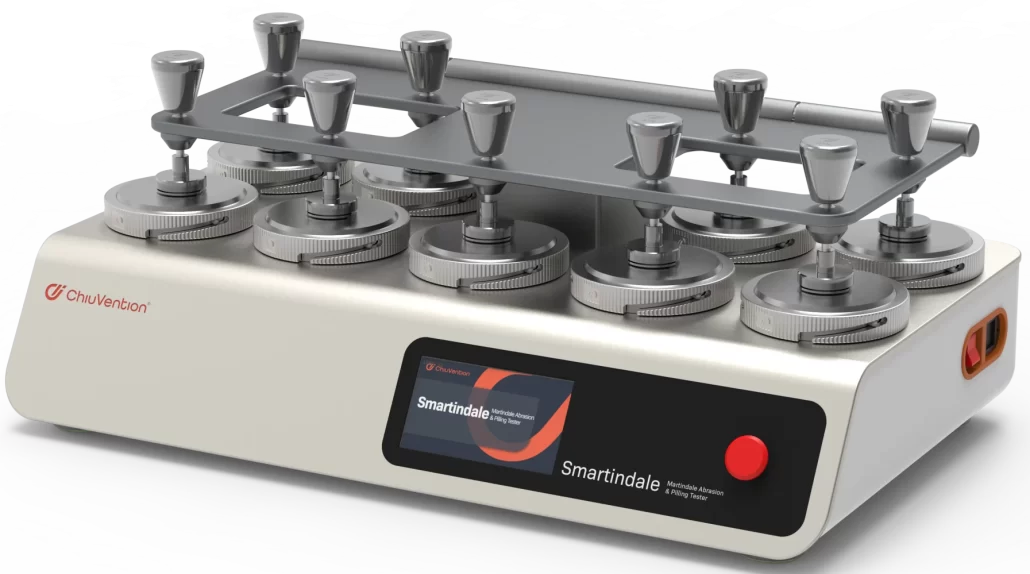1Pilling and Pilling Test Method
A fair, objective test of fabrics’ anti-pilling performance helps to create quality textiles. Many anti-pilling test methods exist. They mainly simulate hairball formation on fabrics from daily use and washing. Different test methods are available for various target markets. These include the American, European, and Chinese standards, and the customer’s standard. The test methods are usually based on the export location, product type, or buyer’s requirements. We usually must choose a test method. It must fit the export place, product type, or buyer’s requirements. The common methods are now: ICI Pilling Box, Martindale Abrasion Teter, Random Cylinder, Elastic Spacer, and Circular Trajectory. Note that the anti-pilling test does not limit to the original sample. Many customers now require tests based on the fabric’s pilling after washing. Some customers use post-wash tests to check the fabric’s anti-pilling.
ICI Pilling Box Method
The test is to take square specimens of a certain size from the tested fabrics along the warp and weft. Sew two of these into tubes, with the front side out, on a polyurethane sample carrier tube. Then, put them into a cork-lined box. As requested by the customers, we will turn over the test box at 3600 revolutions per minute. Next, remove the specimens. Then, compare them to the original or standard fabric samples in the rating box. Assess the pilling level. Use the worst, best, and best when it’s the worst, and the best when it’s the best. Grade 1 is the worst. Grade 5 is the best. If the result falls between two neighboring grades, we can assign a half grade. Common test standards are ISO 12945-1, and IWS TM 152. They mainly simulate pilling from friction between the fabric and other objects. You can apply the test method to all types of fabrics. But, it is mainly used for knitted jumpers for the domestic and European markets. It checks their anti-pilling performance.
Random Cylinder Method
The martindale abrasion test involves three steps. First, take three square samples from the fabric at a 45° angle. Second, seal the edges with glue and dry them. Third, add some lint shavings (none for the JIS L 1076 D3 method). Next, put the samples into a rotating cylinder. It should spin at about 1,200 RPM for 30 minutes (some customers require 60). After that, compare the samples to the standard ones in the rating box to assess pilling. Grade 1 is the worst, and grade 5 is the best. If the results are the same, compare them to the standard samples. Grade 1 is the worst. Grade 5 is the best. You can assess a result between two adjacent grades as half a grade. The main simulation of the fabric tested its high-frequency friction. It also tested its friction with the outside world and its outside fibres. This involved the pilling situation. Most fabrics exported to the U.S. use this method to test their anti-pilling performance. Common test standards are ASTM D3512; JIS L 1076 D3; and CAN/CGSB-4.2 NO.51.2, Grade 3.5. This is the acceptable level.
Elastic Gasket Method
The test’s principle is to take three round specimens from the sample. Load them on the gripper and fix them with a rubber ring. The specimens rub against the elastic gasket with slight pressure. This simulates the pilling that occurs when the fabric rubs against external objects. This method is not widely used. For woven fabrics exported to the US, some buyers test their pilling resistance. They often use a 300-revolution test. The test standard used is ASTM D3514. Grade 1 is the worst, Grade 5 is the best. You can assess results between two adjacent grades as half a grade. Grade 3.5 is Commercially Acceptable.
Circular trajectory method
The test is to take five round specimens from the sample. Load them on the gripper, under a certain pressure, to a circular track. Then, use nylon hair to test the fabric specimens. Next, use a standard fabric for relative friction balling. Use Table 1 to choose the appropriate parameters for the test. After a number of runs, assess the balling grade using the rating box. Compare the fabric to the original or standard sample photos. The grades are: 1, the worst; 5, the best. If the result falls between two levels, you can assess it as half a level. This method works on low-elastic filament woven and knitted fabrics. It also applies to pure and blended chemical fiber fabrics.
Martindale Abrasion Teter Method
The martindale abrasion test is to take three pairs of round fabric specimens. They loaded them in the upper and lower clamps, applying slight pressure. The specimens rubbed against each other, according to the LiShaJu trajectory friction curve. After a set number of revolutions, the raters rated the specimens. We compared them to the original fabric and a standard sample photo. The rating system evaluated the pilling on a scale of 1 to 5, with 1 representing the worst and 5 indicating the best. If the results fell between two levels, evaluators rated them at half a level. This method is applicable to all types of fabrics, but more often used in woven fabrics. When fabrics rub against each other more, they cause pilling. This method mostly tests woven or tightly knitted fabrics for pilling. It is for fabrics for the domestic market or for export to Europe. Commonly used test standards are ISO 12945-2, GB/T 4802.2, IWS TM 196, ASTM D4970. ASTM D4970 is an American standard, and there are relatively few buyers using this method. Grade 3.5 is commercially acceptable.
2 Pilling improvement measures
The intro to fabric pilling test method will help manufacturers. They can use it to develop new fabrics with specific anti-pilling requirements. And they should check the source, choose good raw materials, and use proper processes. They should also evaluate all fabric properties. This will help them optimize the design, performance, quality, and cost of the fabrics. Once test results can no longer meet the requirements, it is too late. Remedial measures often can’t improve things further.
2.1 In weaving, choosing raw materials and technology is key. Please pay attention to the following points:
(1)When choosing pure spinning staple fibre fabrics, consider the fibre length and the mix of coarse and fine fibres. If using shorter fibres with a poor uneven rate, the yarn will be hairy. This will also lead to poor results in unblended fabrics, such as cotton, pure viscose, and pure wool.
(2) A better twist in the yarn can help. So can using a tightly woven fabric.
(3) Select the right process. Ring-spun yarn is better than air-spun for anti-pilling. Combed fabrics are better than coarse ones for anti-pilling.
(4) And short fibre fabrics blended with chemical fibres. These can use anti-pilling fibres. Now, there are anti-pilling polyester and acrylic fibres on the market. They can improve the anti-pilling performance of the fabric. Can also choose a shaped cross-section of the chemical fibre. Compared to the round cross-section, its fabric has better anti-pilling performance.
(5) Synthetic fibers can be chemically modified. This changes the polymers’ internal structure. It reduces the fibers’ breaking strength. The blended staple fabrics with the pomade are now easier to shed than those made with regular polyester. This improves the fabric’s anti-pilling performance.
2.2 Finishing stage
Customers often consult us about improving the anti-pilling of finished fabrics. They want to ensure that the re-test will pass. For woven fabrics, only the finishing process can improve their anti-pilling. But, it often has limited success and a high risk. Improper treatment may weaken the yarn and damage the fabric. This can reduce the fabric’s overall strength and other performance indicators.
Physical methods include burning, shearing, heat setting and resin finishing processes. Burning can better remove surface hair from the fabric. But, excessive burning will weaken the fabric, harden it, and cause uneven dyeing. It may also damage its performance. Heat shaping can improve a fabric’s stability. It makes the surface flat and reduces pilling. But, it is not as good as burning finishing. Resin finishing uses a resin coating process. It bonds the fabric’s surface fibers, internal fibers, and fiber junctions. This prevents the fibers from moving or tangling during rubbing. It helps resist pilling. However, too much resin can make the fabric feel stiff and hard. It also makes the fabric less washable. If there’s too little resin, it won’t work.
Two methods are often used to improve fabrics’ anti-pilling. They use chemicals.
(1)Biological enzymes can finish cellulose fibres. This treatment digests the fluff on the fabric’s surface. It cleans and smooths the fabric, improving its anti-pilling performance.
(2) Mercerising treatment can also help remove the fabric’s hairiness. This, in turn, greatly improves its anti-pilling performance.
(3) The use of anti-pilling agents can significantly improve individual fabrics.
For more information on textile testing methods/standards
or textile testing machines, contact us:
What’s App: +86 180 2511 4082
Tel: +86 769 2329 4842
Fax: +86 769 2329 4860
Email: medium@chiuvention.com


